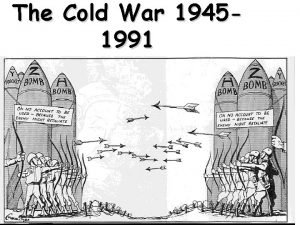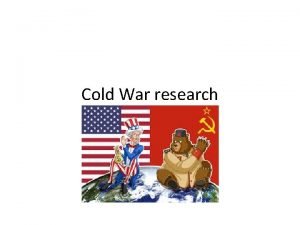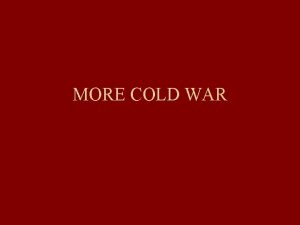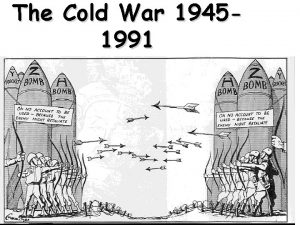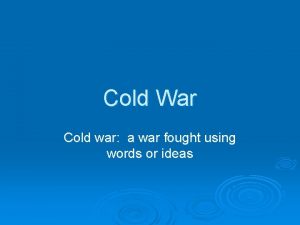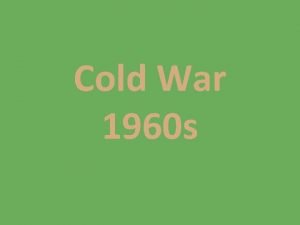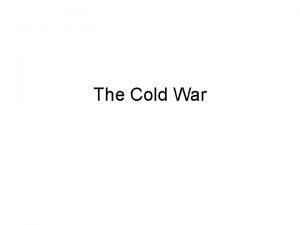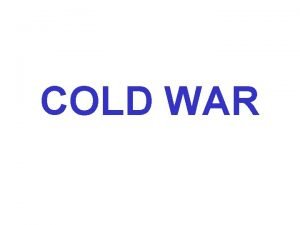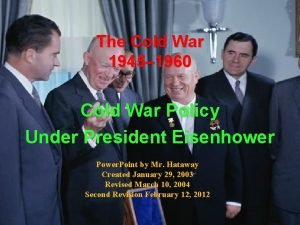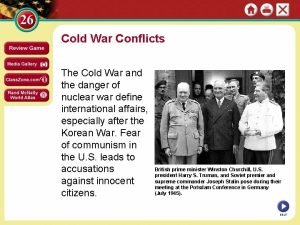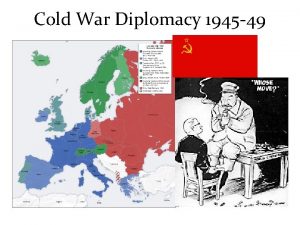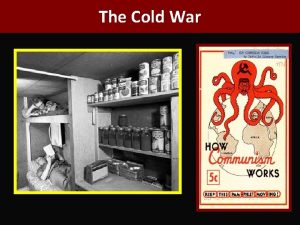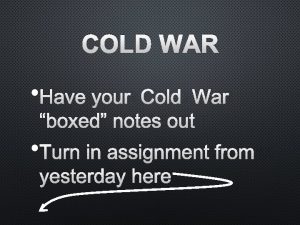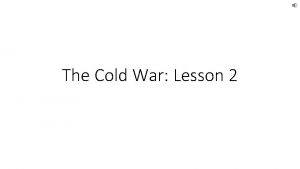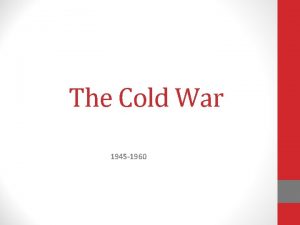An overview of the Cold War Cold War































- Slides: 31

An overview of the Cold War

Cold War • The tension and rivalry between the USA and the USSR was described as the Cold War (1945 -1990). • There was never a real war between the two sides between 1945 and 1990, but they were often very close to war (Hotspots). Both sides got involved in other conflicts in the world to either stop the spread of communism (USA) or help the spread of communism (USSR).

After World War II the Cold War began and caused tension throughout the world. • The USA and the USSR were the two world Superpowers. • The USA was a capitalist society with a democracy. • The USSR was a communist country with a dictatorship. • Both wanted to be the most powerful nation in the world.


To the Victors go the Spoils WWII is over, and the Allies have to decide what to do with Germany. The decision is to split the country into four parts: The NW corner – Great Britain The SW corner – France The NE corner – Soviet Union (USSR) The Central and the SE corner – USA France, the US, and Great Britain want Germany to become a democracy, while the USSR wants Germany to become communist.

Iron Curtain – A term used by Winston Churchill to describe the separating of Those communist lands of East Europe from the West.

The Solution • Germany, which had been ruled by the Hitler and the Nazis until their defeat in 1945 was split in two. • The western side became West Germany (a democracy) and the eastern side became East Germany (communist).

One Little Problem Berlin • Even though Berlin was in the communist side, East Germany, the Allies wanted part of this major city. • Solution – Berlin was divided into a democratic side (West Berlin) and a communist side (East Berlin).

Improve your knowledge • The Russians took very high casualties to capture Berlin in May 1945. They spent the early occupation trying to take over all zones of the city but were stopped by German democrats such as Willy Brandt and Konrad Adenauer. Reluctantly the Russians had to admit the Americans, French and British to their respective zones.

The Berlin Wall 1961 The wall was to keep the Eastern Berliners on their side. People were desperate to make it to the western, or democratic, side.

Things get Sticky • West Berlin, as an outpost of Western democracy and economic success deep within the Communist zone, was both a nest of spies for both sides and a constant challenge to the Soviets. The Berlin Blockade was an attempt to starve the city into submission and the Allied airlift signalled the West’s determination to use all resources to defend Berlin. Thereafter, it was accepted by both sides that Berlin would act as the trigger for general war. Any Russian invasion would be followed by conflict with the considerable Allied forces camped permanently on the plain of West Germany. Both sides finding Europe too dangerous a site for confrontation, looked elsewhere to compete.


The domino effect • The USSR had a lot of influence over many of the new communist countries (especially those in Europe). • The USA was very worried that the USSR’s influence over these countries was making the USSR and communism more powerful. • The USA did not want communism to spread any further – they were worried about the domino effect (one country becomes communist, then another etc)

After World War II, the world changed! Many countries became communist after WWII - North Korea (1945) - Poland (1947) - Hungary (1947) - Czechoslovakia (1948) - China (1949) - Cuba (1959)

Snake Eating Western Europe

Nuclear tensions • The USA had shown its atomic power when it exploded the A-bombs on Hiroshima and Nagasaki at the end of World War 2. • The USSR was also developing atomic weapons/bombs. • The USA and the USSR were in competition with each other to have the best, most powerful weapons in the world – this was called the Arms Race.

Improve your knowledge • The nuclear bomb gave America a lead which was expected to last at least 5 years. The rapid Russian development of nuclear technology, helped by the work of the “atom spies” was a shock. Significantly, Russia hurriedly declared war against Japan at the beginning of August 1945 and rushed to advance into Asia to stake out a position for the postwar settlement. This helped make both the Korean and Vietnamese conflicts more likely.

Each side built up their weaponry, but didn’t want to use it. The two Superpowers didn’t want to start another all out war, WWIII.


Hotspots in the Cold War • Even though neither side wanted to use the pile of weapons they had amassed, for fear of starting WWIII, there was some fighting.

The Korean War 1950 -1953

The Cuban Missile Crisis 1962

The Vietnam War c. 1963 -1975

Eastern Europe Rebels

The Soviet Union Collapses

Communism Loses Its Foothold in Eastern Europe


Steps to Analyzing Cold War Political Cartoons 1. Note the creator of the cartoon. See if you can determine anything 2. 3. 4. 5. about him/her that may impact the opinion being expressed. What newspaper/magazine published the cartoon? What nationality is the creator? Look at the title or caption to obtain clues as to what the cartoonist is trying to say with his/her pictures. Look carefully at the picture. Make a list on a piece of paper of all the people, animals, and items that you see in the visual. Ask yourself if any of the people, etc. in the cartoon represent something like a national symbol, a group of people, or an individual. Make connections between the data you’re collected to determine the political position being expressed.

Stalin’s Demand for Air Control

Soviet Cartoon

The Cold War Again 2011
 The cold war lesson 1
The cold war lesson 1 Cold war sides
Cold war sides Các châu lục và đại dương trên thế giới
Các châu lục và đại dương trên thế giới ưu thế lai là gì
ưu thế lai là gì Thẻ vin
Thẻ vin Các môn thể thao bắt đầu bằng tiếng nhảy
Các môn thể thao bắt đầu bằng tiếng nhảy Tư thế ngồi viết
Tư thế ngồi viết Bàn tay mà dây bẩn
Bàn tay mà dây bẩn Hình ảnh bộ gõ cơ thể búng tay
Hình ảnh bộ gõ cơ thể búng tay Từ ngữ thể hiện lòng nhân hậu
Từ ngữ thể hiện lòng nhân hậu Trời xanh đây là của chúng ta thể thơ
Trời xanh đây là của chúng ta thể thơ Tư thế ngồi viết
Tư thế ngồi viết Thế nào là giọng cùng tên?
Thế nào là giọng cùng tên? Gấu đi như thế nào
Gấu đi như thế nào Thơ thất ngôn tứ tuyệt đường luật
Thơ thất ngôn tứ tuyệt đường luật Sự nuôi và dạy con của hổ
Sự nuôi và dạy con của hổ Diễn thế sinh thái là
Diễn thế sinh thái là đại từ thay thế
đại từ thay thế Thế nào là hệ số cao nhất
Thế nào là hệ số cao nhất Vẽ hình chiếu vuông góc của vật thể sau
Vẽ hình chiếu vuông góc của vật thể sau Lp html
Lp html 101012 bằng
101012 bằng Thế nào là mạng điện lắp đặt kiểu nổi
Thế nào là mạng điện lắp đặt kiểu nổi Cách giải mật thư tọa độ
Cách giải mật thư tọa độ Lời thề hippocrates
Lời thề hippocrates Vẽ hình chiếu đứng bằng cạnh của vật thể
Vẽ hình chiếu đứng bằng cạnh của vật thể Tư thế worm breton là gì
Tư thế worm breton là gì Quá trình desamine hóa có thể tạo ra
Quá trình desamine hóa có thể tạo ra Sự nuôi và dạy con của hươu
Sự nuôi và dạy con của hươu Các châu lục và đại dương trên thế giới
Các châu lục và đại dương trên thế giới Các loại đột biến cấu trúc nhiễm sắc thể
Các loại đột biến cấu trúc nhiễm sắc thể Bổ thể
Bổ thể


































